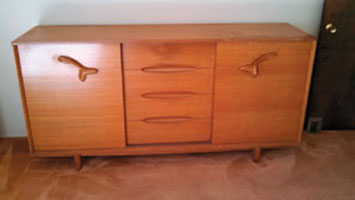
Paul Laszlo designed this credenza or sideboard in America circa 1940-50’s. Made by Brown Saltman of California in bleached ribbon mahogany veneer it sports what I call “crazy” handles. Brown Saltman possessed an uncanny knack for finding GREAT modern designers when “modern” just got off the ground.
RB from Colorado sent me a series of furniture items made of that 1940-1950’s blonde wood, garbage a few years back but today considered HOT, HOT, HOT. It’s not a category of tree, but actually a veneer treated with a light bleaching. My antenna went up. RB didn’t think it anything as emptied out her relative’s apartment on the Central Coast. When I let her know one piecewill likely bring $4,000-6,000 at auction, she answered in me in a 72 point font. “WOW.”
Other designers of this early modern period in furniture design
One of the great furniture designers of all time, Paul Frankl, left Austria, became a hit in New York in the 1920’s, and pioneered the metal “skyscraper style.” He translated the style into architecture, furniture and fine art. When he came to Los Angeles, he opened a gallery on Rodeo Drive serving the likes of Alfred Hitchcock, Katherine Hepburn, Cary Grant and Fred Astaire. He coined the term “Modern Style.” As early as 1930, he wrote Form and Reform: A Practical Handbook of Modern Interiors, and in 1932 Machine-Made Leisure. For Brown Saltman, he designed mass-produced pieces with (remember those crazy handles) biomorphic designs. He pioneered, for Brown Saltman, great usages for weird veneers, like cork.
Paul Evans (1931-1987) used innovative materials like steel, inset slate, sculptured metal, bronze, olived steel and polychromed surfaces. Speaking of Paul Evans, at Rago Arts Auction in Lambertville, NJ, an “important” sculptural front cabinet once sold for $219,750. So Modernist furniture is HOT, as I said, HOT HOT HOT. Check out Los Angeles Modern Auctions for a fun weekend and your eyes will pop out AT THE PRICES THIS STUFF GETS.
Brown Saltman: a story of American ingenuity coupled with the Modernist philosophy
By the 1930’s Paul Frankl thought to move from his rich and famous clients on Rodeo Drive to the general middle class. A savvy business man as well as a great designer, he realized his era had been a time of great economic diversity in America. The 30′s featured both the Great Depression and the Great Hollywood Boom, then with the bombings at Pearl Harbor, a chill hit the spending of the rich and famous.
Paul Frankl met Dave Saltman in the late 1930’s and the two dreamed up the idea of bringing modern furniture to the middle class. By 1941, Frankl ditched his expensive veneers and handmade lines and shifted to cheaper woods and finishes. That necessitated even more machined clean lines, making things with soft woods, and for pop, lacquered or laminated with plywood (a new invention by Donald Desky) called Weldtex.
Brown Saltman’s slogan became to “Live in the Modern Mode.” Frankl’s modern looks in the 1940’s predicted the look which took hold and boomed in the 1950’s. His work at Brown Saltman continues to inspire designers today. Under Frankl’s direction at Brown Saltman, he worked with designers like Paul Laszlo, who gave attention to details – such as RB’s crazy handles and fun legs, knobs, sculptured edges and a pure-wood sleek look.
The Laszlo Journey
Laszlo, a Jewish Hungarian, unwittingly made pieces for Adolf Hitler‘s estate, the Eagle’s Nest, which infuriated Albert Speer, chief architect of the Third Reich. Laszlo fled and made his way to Beverly Hills, like Frankl, and designed, like Frankl, for the Hollywood crowd, featuring Ronald Reagan, Gary Cooper, Debbie Reynolds, Barbara Hutton and Dorothy Lamour. Like Frankl, he realized public opinion changed after Pearl Harbor. He then designed for commercial furniture factories, like Brown Saltman, as well as department stores and casinos in Vegas. Yet he maintained his studio on Rodeo Drive for 25-years. Laszlo concentrated on the integration of whole design production, from architecture to color to furniture.
RB, if you want to know more about the designer of your $4,000-6,000 piece, come here to Santa Barbara. Laszlo donated much of his original materials to the S.chool of Architecture at UCSB.